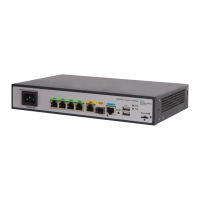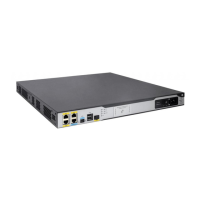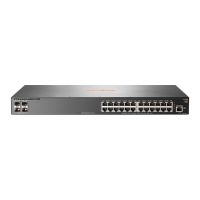23
1. Verify that no error packets have been received on the local port:
a. Execute the display interface command and check for error packets.
<Sysname> display interface Ten-GigabitEthernet1/0/36
GigabitEthernet1/0/25
Current state: UP
Line protocol state: UP
IP Packet Frame Type: PKTFMT_ETHNT_2, Hardware Address: 5cdd-70b1-81a8
……
Last 300 seconds input: 2 packets/sec 427 bytes/sec 0%
Last 300 seconds output: 0 packets/sec 64 bytes/sec 0%
Input (total): 140552 packets, 20207903 bytes
4351 unicasts, 72938 broadcasts, 63263 multicasts, 0 pauses
Input (normal): 140552 packets, - bytes
4351 unicasts, 72938 broadcasts, 63263 multicasts, 0 pauses
Input: 0 input errors, 0 runts, 0 giants, 0 throttles
0 CRC, 0 frame, - overruns, 0 aborts
- ignored, - parity errors
Output (total): 5238 packets, 703647 bytes
3871 unicasts, 2 broadcasts, 1365 multicasts, 0 pauses
Output (normal): 5238 packets, - bytes
3871 unicasts, 2 broadcasts, 1365 multicasts, 0 pauses
Output: 0 output errors, - underruns, - buffer failures
0 aborts, 0 deferred, 0 collisions, 0 late collisions
0 lost carrier, - no carrier
b. If the statistics are not zero, the following failures might occur:
− Interface hardware failure—To test the failure, connect the cable that is connected to
the local port to a correctly operating port (for example, Port A) with the same
configurations as the local port. If Port A forwards traffic correctly, you can determine
that the hardware of the local port fails. In this event, you must replace the local port with
a port that operates correctly.
− Transceiver module, fiber, or twisted pair failure—To test and resolve the failure,
replace the transceiver module, fiber, or twisted pair.
− Inconsistent configurations—Verify that the configurations (including speed and
duplex mode) of the peer are consistent with the local port. If they are inconsistent,
modify the configurations of the local port.
c. If the problem persists, contact Hewlett Packard Enterprise Support.
When you contact Hewlett Packard Enterprise Support, provide the following diagnostic
information if packet loss occurs on the chip port with which the interface is associated:
# Execute the debug port map slot 1 command in probe view to identify the chip port with
which the interface is associated.
[Sysname-probe]debug port map slot 1
[Interface] [Unit] [Port] [Name] [Combo?] [Active?] [IfIndex] [MID] [Link]
==============================================================================
=
GE1/0/1 0 18 ge16 no no 0x1 1 up
GE1/0/2 0 19 ge17 no no 0x2 1 down
GE1/0/3 0 20 ge18 no no 0x3 1 down
GE1/0/4 0 21 ge19 no no 0x4 1 down

